 W
WThe 3-inch gun M5 was an anti-tank gun developed in the United States during World War II. The gun combined a 3-inch (76.2 mm) barrel of the anti-aircraft gun T9 and elements of the 105 mm howitzer M2. The M5 was issued exclusively to the US Army tank destroyer battalions starting in 1943. It saw combat in the Italian Campaign and on the Western Front in Northwest Europe.
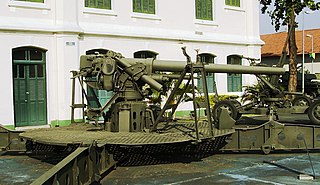 W
WThe 3-inch anti-aircraft gun M3 was an anti-aircraft gun which served throughout the 1930s and possibly into early World War II. Developed from the earlier 3-inch M1917 and 3-inch M1918 guns, it was in the process of being replaced by the time of the US entry into World War II, but was subsequently adapted into an anti-tank gun role, both free-standing and in a self-propelled tank destroyer.
 W
WThe 3-inch gun M1903 and its predecessors the M1898 and M1902 were rapid fire breech-loading artillery guns with a 360-degree traverse. In some references they are called "15-pounders" due to their projectile weight. They were originally emplaced from 1899 to 1917 and served until shortly after World War II. These 3-inch guns were placed to provide fire to protect underwater mines and nets against minesweepers, and also to protect against motor torpedo boats. In some documentation they are called "mine defense guns". The 3-inch guns were mounted on pedestal mounts that bolted into a concrete emplacement that provided cover and safety for the gun's crew.
 W
WThe 3-inch gun M1918 was a United States 3-inch anti-aircraft gun that entered service in 1918 and served until it was largely superseded by the 3-inch anti-aircraft gun M3 in 1930, though the M1918 remained with some National Guard units until early in World War II. The M3 was subsequently replaced by the M1 90mm AA gun early in World War II, primarily during 1942. The M3 3" gun was later adapted for the anti-tank role, serving as the main armament of the M10 tank destroyer during World War II.
 W
WThe 3-inch field gun M1902 (76.2 mm), a.k.a. M1904 and M1905, was the U.S. Army’s first nickel steel, quick-firing field gun with a recoil mechanism. Like its predecessor the 3.2-inch gun M1897, it was a rifled breechloader.
 W
WThe 7.58 cm Minenwerfer a.A. , was a German First World War mortar.
 W
WThe 7.62 cm FK 36(r) and Pak 36(r) were German anti-tank guns used by the Wehrmacht in World War II. The first guns were conversions of the Soviet 76 mm divisional gun M1936 (F-22). Later in the war, the Soviet USV and ZiS-3 76 mm divisional guns were also converted.
 W
WThe 8 cm Feldkanone M.5 was a field gun used by Austria-Hungary during World War I. It was a conventional design, with its most notable feature being its obsolescent autofrettaged bronze barrel, necessary because Austria-Hungary still had trouble making steel of the proper quality. Its development was quite prolonged as the Austrians took years to decide on the proper recoil system and type of breech. Even then production difficulties prevented its introduction into service until 1907.
 W
WThe 8 cm Feldkanone M. 17 was a dual-purpose field and mountain gun used by Austria-Hungary during World War I. Between the wars it was used by Austria, Czechoslovakia, Romania and Yugoslavia. Captured weapons were used by Nazi Germany under the designations 7.65 cm FK 17(ö) or (t) and 7.65 cm FK 303(j).
 W
WThe 8 cm kanon vz. 30 was a Czech field gun used in World War II. Guns captured after the German invasion of Czechoslovakia in March 1939 were taken into Wehrmacht service as the 8 cm FK 30(t). It was used by a variety of German units during World War II, including I./SS-Artillerie-Abteilung 3 between 1939 and 1940.
 W
WThe 8 cm kanon PL vz. 37 (Anti-aircraft Gun Model 37 was a Czech anti-aircraft gun used during the Second World War. Those weapons captured after the German occupation of Czechoslovakia in March 1939 were taken into Wehrmacht service as the 7.65 cm Flak M 37 . 97 were in service during the Munich Crisis in September 1938 of which Slovakia seized one when it declared independence six months later.
 W
WThe 76 mm air defense gun M1931 was an anti-aircraft gun used by the Soviet Union during the Winter War and the first stages of World War II.
 W
W76 mm air defense gun M1938 was a 76.2 mm Soviet air defense gun, created by Soviet artillery designer M.N.Loginov. This gun was a modernized version of the 76 mm air defense gun M1931, with a slightly modernized barrel and a completely new two-axle carriage ZU-8. This carriage was also used for the more powerful 85 mm 52-K air defense gun, developed in 1939.
 W
WThe 76.2 mm divisional gun model 1902 was a Russian light field gun used in the Russo-Japanese War, World War I, Russian Civil War and a number of interwar armed conflicts with participants from the former Russian Empire. Modernized versions of this gun were employed at the early stage of World War II.
 W
WThe 76-mm divisional gun M1933 was a Soviet divisional field gun, which was adopted in limited numbers by the Red Army in 1933.
 W
WThe 76-mm divisional gun M1936 (F-22) was a Soviet divisional semi-universal gun, adopted for Red Army service in 1936. This gun was used in conflicts between the USSR and Japan on the Far East, in the Winter War and in World War II. Many F-22s were captured by the Wehrmacht, modernized by the Germans and used against Soviet forces.
 W
WThe 76-mm divisional gun M1939 was a 76.2 mm cannon produced in the Soviet Union. It was adopted for Red Army service in 1939 and used extensively in World War II. The gun was designated as "divisional" - issued to batteries under the direct control of division headquarters. The F-22 USV was an intermediate model, coming between the F-22, which had limited anti-aircraft capability, and the simpler and cheaper ZiS-3, which eventually replaced it in production and service.
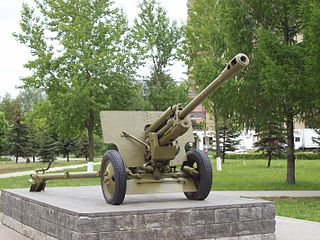 W
WThe 76-mm divisional gun M1942 (ZiS-3) was a Soviet 76.2 mm divisional field gun used during World War II. ZiS was a factory designation and stood for Zavod imeni Stalina, the honorific title of Artillery Factory No. 92, which first constructed this gun.
 W
WThe 76 mm gun M1 was an American World War II–era tank gun developed by the U.S Ordnance Department in 1942 to supplement the 75 mm gun on the basic Medium tank M4. It was also used to arm the M18 Hellcat tank destroyer.
 W
WThe 76 mm gun model 1900, also called 76 mm Putilov M1900 gun, was a light quick-firing field gun of the Imperial Russian Army used in the Russo-Japanese War, World War I, Russian Civil War and a number of interwar armed conflicts with participants from the former Russian Empire.
 W
WThe 76 mm mountain gun M1938 was a Soviet gun used in World War II.
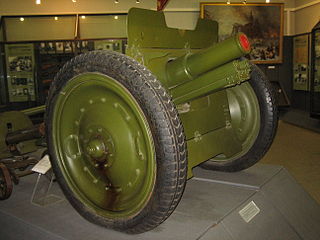 W
WThe 76 mm regimental gun M1927 was a Soviet infantry support gun. The gun was developed in 1927 by the design bureau of Orudiyno-Arsenalny Trest (OAT) and entered production in 1928. A total of 18,116 pieces were built. On June 22, 1941, the Red Army had 4,708 of these guns. In 1943 the gun was replaced in production by the 76 mm regimental gun M1943, but remained in service until the end of the war. The Germans placed captured guns into service as the 7.62 cm Infanteriekanonehaubitze 290(r), while in the Finnish army they were known as 76 RK/27.
 W
WThe 76-mm regimental gun M1943 (OB-25) was a Soviet infantry support gun developed in 1943 by M. Yu. Tsiryulnikov at the ordnance plant in Motovilikha. The gun used a modernized barrel from the 76 mm regimental gun M1927 and the carriage from the 45 mm anti-tank gun M1942 (M-42). The gun was intended for destruction of light field fortifications and openly placed personnel by direct fire. HEAT shells gave it limited anti-armor capabilities. 76.2-mm regimental guns M1943 completely replaced M1927 guns in production that year and were built until the end of the German-Soviet War. Soon after the end of the war the production ceased due to insufficient range and muzzle velocity.
 W
WThe 76 mm tank gun M1940 F-34 was a 76.2 mm Soviet tank gun used on the T-34/76 tank. A modified version of the gun, the 76 mm tank gun M1941 ZiS-5, was used on KV-1 tanks during World War II. Nowadays, the two versions are often referred to just by their factory designations, as "F-34" and "ZiS-5", respectively.
 W
WThe 76 mm Mountain Gun Model 1909 was a rapid-fire mountain gun based on the Schneider-Danglis mountain gun that was used by the Imperial Russian Army during World War I and the Red Army during World War II
 W
WThe Ordnance BL 12-pounder 6 cwt was a lighter version of the British 12-pounder 7 cwt gun, used by the Royal Horse Artillery in the late 19th and early 20th centuries.
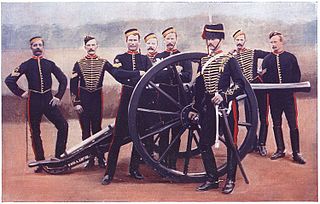 W
WThe Ordnance BL 12-pounder 7cwt was the British Army's field gun, which succeed the RML 13-pounder 8 cwt in 1885.
 W
WThe Ordnance BL 15-pounder, otherwise known as the 15-pounder 7 cwt, was the British Army's field gun in the Second Boer War and some remained in limited use in minor theatres of World War I. It fired a shell of 3-inch diameter with a maximum weight of 15 pounds (6.8 kg), hence its name which differentiated it from its predecessor '12-pounder' 3-inch gun which fired shells weighing only 12.5 pounds (5.7 kg).
 W
WThe Ordnance BLC 15-pounder gun was a modernised version of the obsolete BL 15-pounder 7 cwt gun, incorporating a recoil and recuperator mechanism above the barrel and a modified quicker-opening breech. It was developed to provide Territorial Force artillery brigades with a reasonably modern field gun without incurring the expense of equipping them with the newer 18-pounder. It is the gun that writers usually mean by "15-pounder gun" in World War I, but can be confused with the earlier Ordnance QF 15-pounder Ehrhardt or Ordnance BL 15-pounder, both of which fired the same shell.
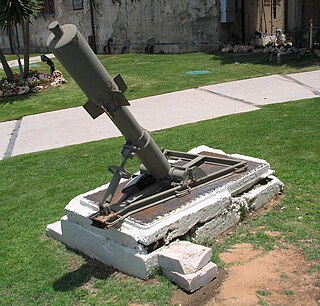 W
WThe Davidka was a homemade Israeli mortar used in Safed and Jerusalem during 1947–1949 Palestine war. Its bombs were reported to be extremely loud, but very inaccurate and otherwise of little value beyond terrifying opponents; they proved particularly useful in scaring away both Arab soldiers and civilians. It is nominally classified as a 3-inch (76.2 mm) mortar, although the bomb was considerably larger.
 W
WThe Fajr-27 system is an Iranian unlicensed copy of the Italian OTO Melara 76mm naval gun.
 W
WThe Ordnance Quick-Firing 17-pounder was a 76.2 mm (3 inch) gun developed by the United Kingdom during World War II. It was used as an anti-tank gun on its own carriage, as well as equipping a number of British tanks. Used with the APDS shot, it was capable of defeating all but the thickest armour on German tanks. It was used to 'up-gun' some foreign-built vehicles in British service, notably to produce the Sherman Firefly variant of the US M4 Sherman tank, giving British tank units the ability to hold their own against their German counterparts. In the anti-tank role, it was replaced after the war by the 120 mm BAT recoilless rifle. As a tank gun, it was succeeded by the 84 mm 20 pounder.
 W
WThe OTO Melara 76 mm gun is a naval gun built and designed by the Italian defence company Oto Melara. It is based on the Oto Melara 76/62C and evolved toward 76/62 SR and 76/62 Strales.
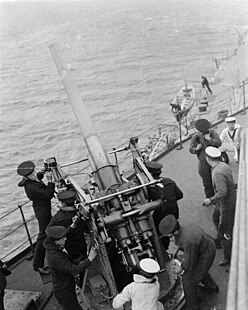 W
WThe QF 3 inch 20 cwt anti-aircraft gun became the standard anti-aircraft gun used in the home defence of the United Kingdom against German airships and bombers and on the Western Front in World War I. It was also common on British warships in World War I and submarines in World War II. 20 cwt referred to the weight of the barrel and breech, to differentiate it from other "3 inch" guns. While other AA guns also had a bore of 3 inches (76 mm), the term "3 inch" was only ever used to identify this gun in the World War I era, and hence this is what writers are usually referring to by "3 inch AA gun".
 W
WOrdnance QF 3 inch howitzer was a howitzer fitted to British cruiser and infantry type tanks of the Second World War so they could fire a smoke shell in "close support" of other tanks or infantry. HE shells were also available. Earlier British tanks were fitted with a 3.7 in howitzer.
 W
WThe Ordnance QF 12-pounder 8 cwt was a Royal Navy "landing gun" intended for navy use ashore. "8 cwt" refers to the weight of the gun and breech, approximately 8 cwt = 8 x 112 lb (51 kg) = 896 lb (406 kg). This was how the British often differentiated between guns of the same calibre or weight of shell. This gun had a short barrel and was of relatively low power compared to the 12 pounders of 12 and 18 long cwt, although it fired the same shells.
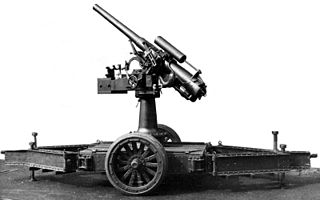 W
WThe 12 pounder 12 cwt anti-aircraft gun was borrowed for AA use from the QF 12 pounder 12 cwt coast defence gun with the addition of a modified cradle for higher elevation, a retaining catch for the cartridge, and an additional spring recuperator above the barrel and high-angle sights. Writers commonly refer to it simply as "12 pounder anti-aircraft gun". 12 cwt referred to the weight of the barrel and breech to differentiate it from other "12 pounder" guns.
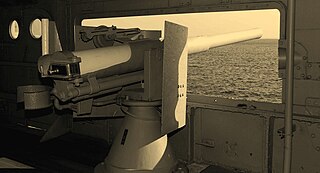 W
WThe QF 12-pounder 12-cwt gun was a common, versatile 3-inch (76.2 mm) calibre naval gun introduced in 1894 and used until the middle of the 20th century. It was produced by Armstrong Whitworth, Elswick and used on Royal Navy warships, exported to allied countries, and used for land service. In British service "12-pounder" was the rounded value of the projectile weight, and "12 cwt (hundredweight)" was the weight of the barrel and breech, to differentiate it from other "12-pounder" guns.
 W
WThe QF 12 pounder 18 cwt gun was a 3-inch high-velocity naval gun used to equip larger British warships such as battleships for defence against torpedo boats. 18 cwt referred to the weight of gun and breech, to differentiate the gun from others that also fired the "12 pound" shell.
 W
WThe Ordnance QF 13-pounder (quick-firing) field gun was the standard equipment of the British and Canadian Royal Horse Artillery at the outbreak of World War I.
 W
WThe Ordnance QF 13 pounder Mk III anti-aircraft gun, also known as 13 pounder 6 cwt, was an early British improvisation in World War I to adapt the 13 pounder field gun to anti-aircraft use. 6 cwt referred to the weight of barrel and breech to differentiate it from other "13 pounder" guns.
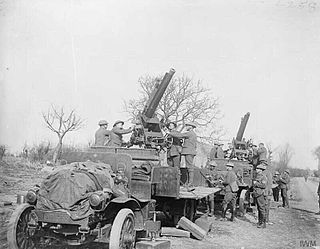 W
WThe 13 pounder 9 cwt anti-aircraft gun became the standard mobile British anti-aircraft gun of the World War I era, especially in theatres outside Britain.
 W
WThe Ordnance QF 13 pounder Mk IV anti-aircraft gun was an Elswick Ordnance commercial 3 inch 13 pounder gun of which 6 were supplied during World War I. It is unrelated to other British Mks of 13 pounder.
 W
WThe QF 14-pounder was a 3-inch medium-velocity naval gun used to equip warships for defence against torpedo boats. It was produced for export by Maxim-Nordenfelt in competition with the Elswick QF 12-pounder 12 cwt and QF 12-pounder 18 cwt guns.
 W
WThe Ordnance QF 15-pounder gun, commonly referred to as the Ehrhardt, was a modern German field gun purchased by Britain in 1900 as a stopgap measure to upgrade its field artillery to modern QF standards, while it developed its own alternative. This was precipitated by the experience of the British Army in South Africa during the Boer War, where its standard field gun, the BL 15-pounder, was out-performed by modern French and German field guns deployed by the Boers. It bore no relation to the BL 15-pounder or BLC 15-pounder, two other guns in British service at the time, other than a common shell.
 W
WThe Ordnance Quick-Firing 17-pounder was a 76.2 mm (3 inch) gun developed by the United Kingdom during World War II. It was used as an anti-tank gun on its own carriage, as well as equipping a number of British tanks. Used with the APDS shot, it was capable of defeating all but the thickest armour on German tanks. It was used to 'up-gun' some foreign-built vehicles in British service, notably to produce the Sherman Firefly variant of the US M4 Sherman tank, giving British tank units the ability to hold their own against their German counterparts. In the anti-tank role, it was replaced after the war by the 120 mm BAT recoilless rifle. As a tank gun, it was succeeded by the 84 mm 20 pounder.
 W
WThe Armstrong Breech Loading 12 pounder 8 cwt, later known as RBL 12 pounder 8 cwt, was an early modern 3-inch rifled breech-loading field gun of 1859.
 W
WThe Ordnance RML 7-pounder Mk IV "Steel Gun" was a British rifled muzzle-loading mountain gun. 7-pounder referred to the approximate weight of the shell it fired.
 W
WThe RML 9-pounder 8 cwt gun and the RML 9-pounder 6 cwt gun were British Rifled, Muzzle Loading (RML) field, horse and naval artillery guns manufactured in England in the 19th century, which fired a projectile weighing approximately 9 pounds (4.1 kg). "8 cwt" and "6 cwt" refers to the weight of the gun to differentiate it from other 9-pounder guns.
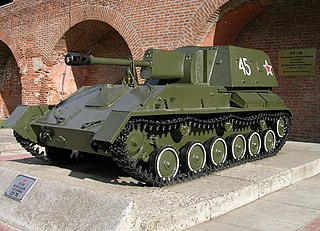 W
WThe SU-76 was a Soviet light self-propelled gun used during and after World War II. The SU-76 was based on a lengthened version of the T-70 light tank chassis and armed with the 76 mm divisional gun M1942 (ZiS-3). Its quite simple construction and multipurpose combat role made it the second most produced Soviet armoured fighting vehicle of World War II, after the T-34 medium tank.
 W
WThe QF 12-pounder 12-cwt gun was a common, versatile 3-inch (76.2 mm) calibre naval gun introduced in 1894 and used until the middle of the 20th century. It was produced by Armstrong Whitworth, Elswick and used on Royal Navy warships, exported to allied countries, and used for land service. In British service "12-pounder" was the rounded value of the projectile weight, and "12 cwt (hundredweight)" was the weight of the barrel and breech, to differentiate it from other "12-pounder" guns.